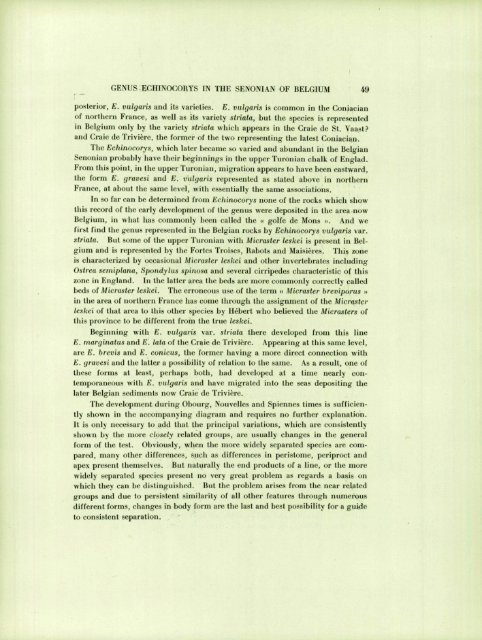ECIIINOID GENUS ECHINOCOIÎYS
ECIIINOID GENUS ECHINOCOIÎYS
ECIIINOID GENUS ECHINOCOIÎYS
You also want an ePaper? Increase the reach of your titles
YUMPU automatically turns print PDFs into web optimized ePapers that Google loves.
<strong>GENUS</strong> ECHINOCOBYS IN THE SENONIAN OF BELGIUM 49<br />
posterior, E. vulgaris and its varieties. E. vulgaris is common in the Coniacian<br />
Of northern France, as well as its variety striata, but the species is represented<br />
in Belgium only by the variety striata which appears in the Craie de St. Vaast?<br />
and Craie de Trivière, the former of the two representing the latest Coniacian,<br />
The Echinocorys, which later became so varied and abundant in the Belgian<br />
Senonian probably have their beginnings in the upper Turonian chalk of Englad.<br />
From this point, in the upper Turonian, migration appears to have been eastward,<br />
the form E. gravesi and E. vulgaris represented as stated above in northern<br />
France, at about the same level, with essentially the same associations.<br />
In so far can be determined from Echinocorys none of the rocks which show<br />
this record of the early development of the genus were deposited in the area now<br />
Belgium, in what has commonly been called the « golfe de Mons ... And we<br />
first find the genus represented in the Belgian rocks by Echinocorys vulgaris var.<br />
striata. But some of the upper Turonian with Micraster leskei is present in Belgium<br />
and is represented by the Fortes Troises, Rabots and Maisières. This zone<br />
is characterized by occasional Micraster leskei and other invertebrates including<br />
Ostrea semiplana, Spondylus spinosa and several cirripedes characteristic of this<br />
zone in England. In the latter area the beds are more commonly correctly called<br />
beds of Micraster leskei. The erroneous use of the term « Micraster breviparus »<br />
in the area of northern France has come through the assignment of the Micraster<br />
leskei of that area to this other species by Hébert who believed the Micrasters of<br />
this province to be different from the true leskei.<br />
beginning with E. vulgaris var. striata there developed from this line<br />
E. marginatus and E. lata of the Craie de Trivière. Appearing at this same level,<br />
are E. brevis and E. conicus, the former having a more direct connection with<br />
E. gravesi and the latter a possibility of relation to the same. As a result, one of<br />
these forms at least, perhaps both, had developed at a time nearly contemporaneous<br />
with E. vulgaris and have migrated into the seas depositing the<br />
later Belgian sediments now Craie de Trivière.<br />
The development during Obourg, Nouvelles and Spiennes times is sufficiently<br />
shown in the accompanying diagram and requires no further explanation.<br />
It is only necessary to add that the principal variations, which are consistently<br />
shown by the more closely related groups, are usually changes in the general<br />
form of the test. Obviously, when the more widely separated species are compared,<br />
many other differences, such as differences in peristome, periproct and<br />
apex present themselves. But naturally the end products of a line, or the more<br />
widely separated species present no very great problem as regards a basis on<br />
which they can be distinguished. But the problem arises from the near related<br />
groups and due to persistent similarity of all other features through numerous<br />
different forms, changes in body form are the last and best possibility for a guide<br />
to consistent separation.

















